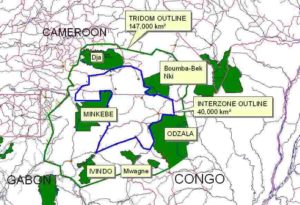
TRIDOM Landscape: Protected Areas Dja, Odzala & Minkebe
Story from Anne Ntongho, WWF.
Three African coaches – Gilles Etoga, Stephane le Duc and Anthelme Allam, facilitated a process to update a 5-year strategic plan for one of the biggest priority landscapes of the Congo Basin, the TRIDOM landscape.
Spread over Cameroon, the Republic of Congo and Gabon, TRIDOM gets its name from the initials of Dja,Odzala and Minkébé – three famous protected areas, each in a different country. The huge TRIDOM forest covers 178,000 km², or 10% of the whole Congo Basin rainforest. The area is a haven for large mammals: it shelters up to 25,000 elephants and 40,000 gorillas and chimpanzees, as well as a host of other species, including buffaloes, giant forest hogs, sitatunga, pythons, and monkeys.

TRIDOM Open Standards workshop to update strategic plan in Ebolowa, Cameroon, 2017.
Representatives from all three countries (Cameroon, Gabon & Congo Brazzaville) and also from both Administrative Agencies and NGOs working with them, met at an Open Standards workshop in Ebolowa, Cameroon. Participants reviewed the scope of the TRIDOM landscape as established by the heads of state in the “TRIDOM Accord”, and incorporated the adjacent Minvul-Kyossi area into the assessment (which is not part of the scope as per the agreed Accord), but where ivory dealers pose an increasing threat.
The updated strategic plan now includes pangolin and parrots, that were not considered before, as a result of the up-listing of the former and increased pressure on the latter. The major threats were still the same but the approaches to address them were reviewed, resulting in four strategies: 1) Improve governance on law enforcement; 2) BAKA (Break the chain with white collar poachers); 3) Best practices and 4) Land use planning.
As a result of this work, this important landscape now has an updated strategic plan that also incorporated climate change considerations.
